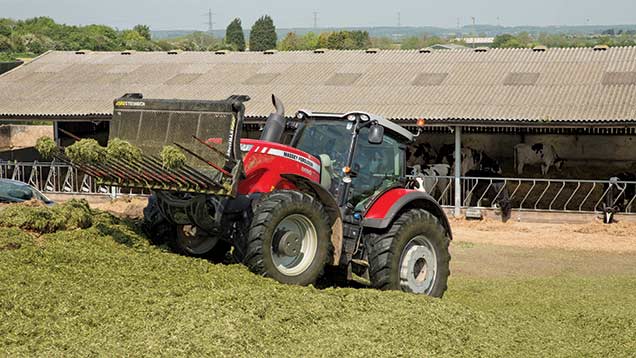Key silage figures could help maximise milk yields
 ©Tim Scrivener
©Tim Scrivener Farmers are being urged to look beyond the headline silage analysis figures to get the most out of their first cuts this winter.
Armed with their silage analysis figures, farmers will now be looking at their winter rations with a lot of attention on dry matter (DM), protein and energy contents.
But they can gain more from the other figures, rather than just concentrating on metabolisable energy (ME), dry matter and protein.
See also: Strict monitoring of freshly calved dairy cows helps improve transition health
“Cows don’t milk off metabolisable energy, instead they milk off the nutrients consumed. How much nutrient the cow eats and how efficiently she uses it determines performance.”
For example, a 12MJ ME/kg DM silage sounds attractive, but if cows can only consume 8-9kg of DM, the benefit of a higher energy level is lost.
In contrast, a lower-energy 10.5ME silage could prove more valuable overall if cows eat more of it, says Trouw Nutrition ruminant manager Adam Clay.
Intake is king
Looking at the silage analysis sheet, intake potential is a useful guide of whether a silage has good or bad intake characteristics, he says.
“Take the average figure for this year’s first-cut silage, which is 92-93g/kg of metabolic liveweight. This is a poor figure and it means you can’t assume a 12kg/day forage dry matter intake.”
Diets will fall down if they rely on high forage intakes. Mr Clay adds that intake is more important than ME value. “If your silage has 0.5MJ/kg less energy at 10.5MJ/kg DM, assuming a 10kg/day intake, overall energy intake would be 5MJ less, which equates to a litre of milk.
“But if you lose 1kg of dry matter intake, you are 11MJ down, which equates to two litres of milk.”
Rumen health
To achieve high intakes, you need good rumen health. This requires a good mix of rapidly and slowly fermentable carbohydrates and protein, he explains.
“On silage analysis sheets, there is a figure for rumen stability, but I would rather look at other measures,” he says.
The first is neutral detergent fibre (NDF), which together with the physical composition of the diet is essential for the development of a good rumen mat.
NDF levels are higher in first-cut silages this year, as grass was more mature when cut. Good levels of fibre will also stimulate milk fat.
“This is a positive for this year’s first-cut silage, but is the only positive,” Mr Clay says.
A key downside of this year’s first cuts are the high lactic acid levels. “It is a strong acid in the rumen and can rapidly reduce pH levels, thus compromising rumen health.”
Farmers can add structural fibre to help alleviate the acid loading, but he says it will not be sufficient and adding more fibre will dilute the energy level.
Therefore, rumen buffers will have a role to play this winter. “If you suspect there will be an acid problem, use a buffer before you see any problems. If you see problems in cows, it is too late – act on the silage analysis,” he advises.
Another negative is the lower DM content with this year’s first cuts being wetter. There is less dry material to form a rumen mat, so adding a drier second-cut silage to the ration can help.
Second cuts
It is an unusual year in that second cuts have a higher DM and ME than first cuts, with a higher intake potential. “This year, 21% of first cuts tested had an ME of 11MJ/kg DM or higher, but for second cuts, it was higher at 33%,” explains Mr Clay.
Winter rations
He advises starting off with rations assuming 9-10kg of silage DM intake and if cows clear up, lift inclusion levels, rather than start high and see production and health suffer.
More importantly, he warns against cutting back on feed costs in response to the lower milk prices.
“Cutting back usually means lower-quality feeds that are more rapidly fermentable and put more pressure on the rumen,” he warns.
|
Factor |
Analysis figure |
First cut 2014 |
|
Energy |
Metabolisable energy |
Down this year, but intake has bigger impact on overall nutrient intake |
|
Intake |
Intake potential |
Based on near infrared (NIR) analysis. Lower this year and will be key this winter |
|
Rumen health |
Dry matter, lactic acid, NDF |
First cuts have poorer rumen health characteristics |
|
Milk butterfat |
NDF |
The high NDF levels are the only positive |
|
Protein |
Crude protein |
Not an issue |
